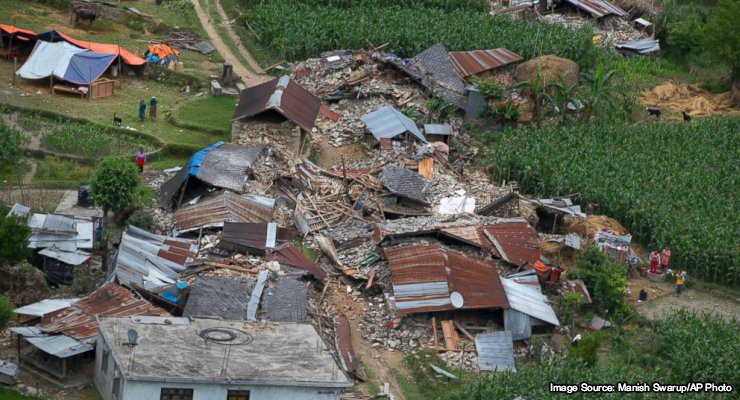The Secret to Earthquake Preparedness
Wednesday, May 20, 2015

It is really sad to see what has recently happened in Nepal, Hati, Chile and other places around the world. After a major incident, there’s a good chance that public safety services will be busy handling emergencies. Your best defense is to be prepared at all times.
Before we get hit by the BIG ONE in Southern California:
Be prepared. Know where your gas meter is located. Even in the case of an earthquake or other emergencies, turn off your gas meter ONLY if you smell gas or hear gas leaking.
Better yet, make sure your home is equipped with earthquake Activated gas shut off valve from Kevin Shaw Plumbing, Inc.
To help prevent your water heater from moving or toppling in an earthquake, strap it firmly to the wall studs in two places — the upper and lower one-third of the tank — with heavy bolts and metal tape. Be sure to place the lower strap at least 4 inches above the thermostat controls. Fill out our handy dandy on-line order form here, or give us a call @ 626-359-1864.
Make sure that all semi-rigid aluminum or copper gas connectors have been upgraded with approved flexible metal appliance connectors.
Check safety devices, such as smoke and carbon monoxide detectors, to ensure that they are functioning properly. Have extra batteries available.
Check your furnace and other gas appliances for safe operation. Call us @ 626-359-1864 to make any needed repairs.
Emergency Plan:
Most of us have at one time or another thought about what we would do in the event of an emergency. Unfortunately, too many of us never go beyond just thinking about it. Even worse, some people believe having stored food supplies and a few thoughts about what they would do in an emergency is being prepared. The truth is without formalizing your thoughts on how you want to approach various emergencies you are not prepared. In other words, being prepared means not only having supplies but having a written plan that includes training and practice. Developing a written plan not only organizes your thoughts it also provides a systematic and repeatable approach to emergencies. It’s also an excellent tool for training and practicing.
Your plan should be tailored to meet your specific situation and the special actions required to meet specific types of emergencies. For example, what action should be taken in the event of a fire versus an earthquake or flood. Here are a few examples of emergencies for you to consider:
— House or wild fire
— Flooding
— Earthquake
— Intruder
— School or work emergency
— Large chemical spills near your neighborhood
Create an emergency plan for your family, identifying two places for the family to meet.
#1 a place outside your home
#2 a spot away from your neighborhood in case you can’t return home.
Practice the plan with your family, including your children
Make sure your children are aware of the routes away from home.
Develop a plan for family pets and livestock. Evacuation shelters may not allow animals.
Plan safe routes away from your home and business to high, safe ground.
Designate a friend outside the area who family members can call if separated.
Review the emergency plans at your workplace, your children’s school or daycare center and other places where members of your family regularly spend time away from home.
Review and update your plan, as needed, at least annually.
Keep current important documents in a safe-deposit box.
Know if your home is in an area at risk of flooding or landslide.
Check the condition of your roof.
Clean debris from drains around your home or yard.
Emergency Supply checklist:
Now is the time to stock up on at least 72 hours worth of emergency supplies that add to your safety and comfort during and after an earthquake.
Below are some essential items to include in your emergency preparedness kit:
Bottled water – three day supply of bottled water (one gallon per person, per day)
First-aid kit, handbook, and essential medications
Packaged, dried or canned food and any special diet items
Special provisions for babies, elderly, disabled family members, and pet
Non-electric can opener
Blankets or sleeping bags
A portable radio, flashlight, batteries and light sticks
Extra eyeglasses and sets of house and car keys
Fire extinguisher –A-B-C type
Rubber boots, rain poncho,
Plastic trash bags
Sturdy pair of shoes, warm clothing and personal hygiene items
Cash
After an Emergency
DO NOT turn off your meter unless you smell gas or hear gas leaking.
Contact a licensed contractor or your gas company to relight any gas appliances or pilot lights that are out. Do not turn gas back on by yourself.
It is recommended that a shut-off valve be installed at every gas appliance. If a leak occurs at a specific appliance, the valve will permit you to turn off the gas at the appliance rather than shutting off all gas service at the meter. Some valves require a wrench to turn them.
Check your water heater and furnace vents. If the venting system becomes separated during an earthquake, it could leak hazardous fumes to your home. Signs of an improperly vented appliance may include moisture on the inside of windows or an unusual odor when the appliance is in operation.
DO NOT use any electrical appliances until you’re sure there are no gas leaks.
Keep informed of the situation through local radio and TV.
If evacuation is necessary, prepare an evacuation kit, including personal hygiene items, change of clothes, bedding and medication, if possible. Food, shelter and first aid are available at shelters.
If it is safe to do so, check on your neighbors, especially elderly and disabled persons.
Use the telephone only for family emergency needs or to report unsafe or dangerous conditions.
Do not use 911 unless you have a life-threatening emergency.
Avoid unnecessary trips. If you must travel during an emergency, dress in warm, loose layers of clothing and sturdy shoes. Advise others of your destination.
Use flashlights — NOT lanterns, matches or candles — to examine buildings. Flammable gases may be inside.
Follow instructions of local authorities regarding the safety of drinking water. If in doubt, boil or purify water before drinking or call public health officials.
Avoid “sightseeing” in disaster areas. You may hamper rescue efforts or place yourself in danger.
Earthquake Preparedness
Do a Home “Hazard Hunt.”
Walk through your rooms and look for things that could fall when shaken. Identify good places to “duck ,cover and hold” (see below). Even though you may not be able to secure every item you believe could fall, at least you will have identified the safe and unsafe areas of your home. Their fresh eyes can often find things you miss.
Practice your “Duck, Cover and Hold.”
Duck or drop to the floor, take cover under a sturdy desk or table, and hold onto it. If you have children, teach them how to “duck, cover and hold”, and be sure to practice it with them often.
During an Earthquake
Duck or drop to the floor, take cover under a sturdy desk or table, and hold onto it so that it doesn’t move away from you. Wait there until the shaking stops.
Other Helpful Emergency Links
For other emergency preparedness or related information, visit any of these helpful sites:
California’s Office of Emergency Services
The American Red Cross
Federal Emergency Management Agency
US Geological Survey
 years of In The Field experience, Kevin has the skills and know how to fix most any plumbing, heating, air conditioning and insulation problem and makes it a priority to stay abreast of the latest needs in customer satisfaction as well as technical advances. He has served as the President of the
years of In The Field experience, Kevin has the skills and know how to fix most any plumbing, heating, air conditioning and insulation problem and makes it a priority to stay abreast of the latest needs in customer satisfaction as well as technical advances. He has served as the President of the 

